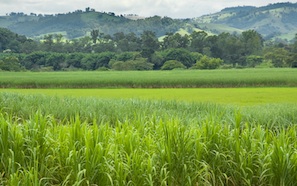CACHAÇA is a hulking heavyweight of a category. With a billion bottles sold a year it dwarfs the likes of gin, tequila and cognac (Euromonitor International). And, contrary to popular belief, Brazil’s national spirit more than keeps apace with production of rum in the whole of Latin America. Yet, despite its almighty scale, cachaça is a domestic deity. A lopsided 99% of consumption of the sugarcane spirit happens under the sunny skies of Brazil. Where cachaça is concerned, international markets remain largely in the dark.
Global enlightenment has long been on the agenda, though. There has been talk of cachaça’s enormous potential, its diversity of styles, the delicious and marketable Caipirinha cocktail and the current cult popularity of everything Brazilian. But meaningful actions from the category’s prominent players have yet to follow words. Historically the category’s biggest barrier to global domination has also been one of its strengths. Cachaça is the treasured drink of a country that is a provincial town away from numbering 200 million people. While there have been enough thirsty mouths, cachaça brands have been content within their own borders.
Volume down
But with domestic volume sales having dipped by about 1% – the fifth consecutive year of decline (Euromonitor) – there is a growing acceptance that future growth will not come from cachaça in its traditional, commodity form. There is an increasing embracement, theoretically at least, that international markets may finally have a role to play – though probably now more out of necessity than adventure.
“The Brazilian cachaça industry shouldn’t rest on its laurels in Brazil and continue to wait for the world to come and invite it to the major league of world spirits,” says Cosme Gomes, head of business development for super- premium cachaça brand Bossa. “Brazilian producers should be more present abroad – investing, refining its messaging, innovating, acquiring brands and forming partnerships.”
And what better time to take product to market than when the culture and back-story of the category is about to be projected into the living rooms and bars of the world? For international- facing super-premium brand Cabana Cachaça, the opportunities of the 2014 World Cup and 2016 Olympics don’t confine themselves to the sporting period. “Important in my opinion is how any momentum from those events can be leverage for long-term, sustainable success,” says brand founder and CEO Matti Antilla.
Premium exports
For most of the heavyweight cachaças, exports appear an afterthought. It is brands at the premium end of the business that are asking all the questions of the category’s international suitability. As a potential growth export market, the US is increasingly looking like the answer. Estimates vary as to the size of the US cachaça market – possibly due to the confusion caused by its classification as Brazilian Rum – but according to Gomes the US is set to surpass Portugal as cachaça’s second export market, behind Germany at somewhere around 160,000 cases.
One of the most active brands in the market has been the self-styled ultra- premium Leblon, which is finished in XO cognac casks. Part-owned by Bacardi, the brand has attracted attention with the Legalise Cachaça campaign – a marketing stunt aimed at raising awareness by sniping at US drinks regulators. Perhaps they’ve been listening, in April 2012 it was announced that the US would officially recognise cachaça as a spirit from Brazil, meaning it no longer has to be labelled Brazilian rum.
Bossa, another front-runner of the American movement, claims to be growing in double digits every year. “It’s exciting to be part of this first generation to break out of Brazil,” says Gomes. “The US market is in some ways one of the most open markets in the globe because American consumers have no issues falling in love with a foreign brand – and that’s not the case everywhere. Most new major brands have been born or became famous in the US before hitting the world markets – Patrón, Hendrick’s, Skyy, Absolut, Smirnoff even.”
But without an international generic body to homogenise brands and message, and to coordinate campaigns, the likes of Leblon and Bossa blaze lone trails in the market. Cabana Cachaça is another in this vein and, albeit with small volume, it has achieved what has traditionally been seen as unattainable – 70% of its sales come from the US. “It’s the most important market for Cabana right now, as it’s the most receptive to the premium end of the category,” says the brand’s Antilla. “If the premium end of the market can gain traction here then the opportunity globally is significant. One only needs to look at the history of the tequila category as an analogy.”
For Cabana, the development of cachaça’s reputation as a premium product overseas will not only serve the brands with international pretentions. “The growth internationally of the category, driven by more premium brands, is helping to grow demand at the premium end of the market in Brazil,” says Antilla.
The category’s second in command (behind Pirassununga 51) is Pitú, which sold 10.2 million cases in 2010 (Millionaires 2011). Its sales split is 97% domestic and 3% international, but Pitú also has outward ambitions. “Export is surely the answer”, says Andrea Baumgartner, international marketing director of Pitú. “The demand for the category in strong international markets will increase the wish to develop cachaça in the home market.” For Baumgartner it is cachaca’s diversity of range – aged and un-aged, gold and silver styles – that will foster interest overseas. “Perhaps we will see some bars having a diverse range of cachaça as their USP, in the same way as some have embraced tequila.”

|
Cabana sugarcane fields in Jaguariuna, Sao Paulo |
So, counterintuitive as it may sound, the remedy for cachaça’s domestic malaise in volume sales could be found elsewhere. “It may seem like a contradiction but the key to cachaça’s success in this newly affluent Brazil is the international markets, not the other way around,” says Bossa’s Gomes. “Like most countries, Brazil is susceptible to the attraction of the exotic, the foreign. You could say that ‘the spirit is always more premium over the border’. Just look at how the Swedes became proud of Absolut vodka, a previously stodgy government- owned company that later became a cool international brand. Likewise, a similar process will occur in Brazil – when the right cachaça brand reaches a critical mass and gains that ‘coolness factor’ internationally.”
Domestic dedication
That cachaça will probably not be the fourth biggest brand, Ypióca. The fifth-generation, family-owned, 165-year old producer seems content with the domestic market and, with sales of more than 6 million cases this year, it has reason to be. Despite having made an early debut in the US during the 70s and collecting sales invoices from as many as 40 world markets, the brand may just have concluded that the Brazilian market is plentiful enough.
“Our international sales are still very tiny and not relevant compared with the domestic sales,” says Ypióca export manager Guilherme Coelho. “Our strategy has been built aiming at the Brazilian market as we see the potential for growth in the premium segment and innovative products for quality brands.” Though, with a full spectrum of cachaças, which include the super-premium Cachaça Rio and anniversary expression Ypióca 160, the brand, like many others, is developing products that would suit more discerning palates.
Certainly the category leader Pirassununga 51, which sold a Bacardi- bettering 19.5 million cases in 2010 and offers the gamut of styles, isn’t perturbed by the gradual drop in domestic volumes. “The cachaça market is shrinking at a historical rate of about 1-2%,” says the brand’s CEO, Ricardo Gonçalves. “What is important is that the trend is mostly towards increasing value and sophistication of the category.”
Upgraded offering
So perhaps the continuous volume decline in Brazil isn’t actually as dramatic as it sounds. With new wealth among consumers, domestically focused brands have started to evolve and innovate to meet more discerning tastes. Gomes picks up the thread: “The cachaça industry, which until recently was viewed as large but unsophisticated, is now upgrading its offerings, renovating packaging and launching different concepts. What’s new is that a lower-income population is now maxing out the first new credit cards to splurge on anything viewed as previously reserved for wealthy Brazilians.”
In the maelstrom of a rapidly changing marketplace arises the opportunity for newcomers. Diageo’s presence is old news – it’s been testing the water with Nega Fulo for a decade and remains poised, but Pernod Ricard is also lurking with Sao Francisco and Janeiro. Perhaps more significant though are the moves into the burgeoning premium end of cachaça. Rum giant Bacardi’s Leblon and Campari with Sagatiba have the distribution networks, marketing budgets and knowhow to break international markets.
The Italian group’s acquisition, which came in August, was described as the “market leader in the premium cachaça”. Campari had already dipped its toes into the market in 2010, when it distributed the brand, but seemed assured enough to pay US$26m for Sagatiba and says it sold 112,000 cases in 2010 – two-thirds of which was in Brazil. “Sagatiba enables us to tap into the largest segment of the Brazilian spirits market as well as leverage the premiumisation trend being driven by socio-economic improvement,” says Bob Kunze-Concewitz, chief executive officer of Campari.
Since Sagatiba was founded by Brazilian entrepreneur Marcos de Moraes in 2004, the company has expanded to offer a portfolio including aged expressions Velha and Preciosa – aimed at an older demographic who drink the spirit neat – and its un-aged Pura, marketed towards younger drinkers.
Bossa’s Gosmes fears that one day the added competition from the world’s heavyweight drinks groups could spell trouble for brands that rely too heavily on the domestic market. “For now Brazil is big enough for any of the large cachaça manufactures, but the future could be totally different. New players will certainly enter Brazil and threaten their control of that market, especially if they are allowed to grow unchecked internationally.” Talking from opposite ends of the cachaça philosophy, unsurprisingly 51’s Gonçalves disagrees: “We welcome new companies, especially of the size and shape of Diageo, Bacardi and Campari, because they will work to build the market.”
The docking of international drinks groups into port Brazil, whether to trade at the premium end of the domestic market or as a platform for overseas offensives, is surely a compass point in the right direction. Whether the current leaders of the category ever charter a voyage of world exploration of their own remains to be seen. Certainly, with their new premium products on board the journey will be a much smoother one.




